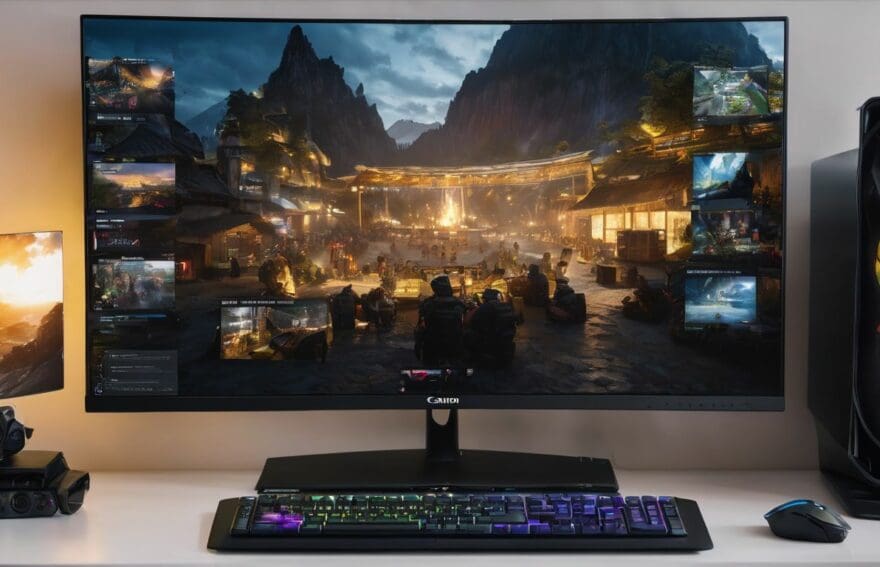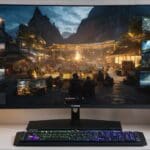Adaptive Sync Technology: G-Sync and FreeSync in Esports Displays

Updated On: November 13, 2025 by Aaron Connolly
Picture the scene: you’re thoroughly engrossed in an all-consuming gaming session, only to have juddering images and vexing screen tearing rudely yank you back to reality. A familiar annoyance for many of us, isn’t it? Fear not, for we’ve delved into the depths of display tech to unearth solutions that promise butter-smooth visuals – a warm welcome to Adaptive Sync Technology.
Our guide thoughtfully illuminates the nuances of G-Sync and FreeSync, bestowing upon your esports monitor the fluidity it truly merits. Are you primed for uninterrupted gaming excellence? Stay with us!
Understanding Adaptive Sync
Adaptive sync technology, also known as variable refresh rate, helps to eliminate screen tearing and stuttering in gaming displays by synchronising the monitor’s refresh rate with the graphics card’s frame rate.
It allows for a smoother and more immersive gaming experience.
What is adaptive sync?
Adaptive sync is a display technology that we appreciate for its ability to match the refresh rate of our monitors with the frame rate our graphics cards are pumping out. This nifty feature prevents annoying screen tearing and reduces stuttering, ensuring that every fast-paced moment in our games looks buttery smooth.
It dynamically tweaks the refresh rate to avoid any lag or judder during explosive on-screen action, which is particularly crucial for us in competitive gaming scenarios.
As passionate gamers, we know too well how disruptive inconsistent frame rates can be to immersion and performance. That’s why adaptive sync technologies like G-Sync and FreeSync have become game-changers in esports displays.
They synchronise our LCD displays’ refresh rates with the variable rates at which our graphics processing units render frames. The result? Seamless visuals that keep us locked into the game without distractions from visual artefacts or delays.
Benefits for gaming displays
Adaptive sync technology offers significant benefits for gaming displays, providing a smoother and more responsive experience. With G-Sync and FreeSync, gamers can expect to eliminate screen tearing and stuttering, leading to improved visual clarity during fast-paced gameplay.
Additionally, this technology dynamically adjusts the refresh rate of the display to match the frame rate of the graphics card, reducing input lag and ensuring a seamless gaming experience.
These advancements are particularly advantageous in esports gaming where every millisecond counts for achieving peak performance.
G-Sync: The Proprietary Solution
G-Sync is a proprietary adaptive sync technology developed by NVIDIA, designed to eliminate screen tearing and stuttering in PC gaming displays. It works by synchronising the monitor’s refresh rate with the GPU’s frame rate, ensuring smooth gameplay.
How G-Sync works
G-Sync works by synchronising the refresh rate of a compatible monitor with the frame rate of the graphics card. This dynamic adjustment eliminates screen tearing and stuttering, providing a smoother and more immersive gaming experience.
G-Sync achieves this by incorporating a proprietary module directly into supported monitors, allowing seamless communication between the display and NVIDIA’s GPUs. When combined, G-Sync technology ensures that each frame is displayed at precisely the right time, reducing input lag and delivering crystal-clear visuals for an enhanced gaming experience.
The integration of G-Sync technology results in variable refresh rates, which adapt to the changing demands of different games. By continuously matching the monitor’s display refresh rate to the GPU’s frame rate output, G-Sync effectively eliminates visual artifacts while maintaining optimal performance during fast-paced gameplay in esports titles.
Advantages and disadvantages
As we delve into the intricacies of G-Sync’s functionality, it’s crucial to weigh the pros and cons of this technology. Knowing the advantages and disadvantages helps us decide whether this proprietary solution from NVIDIA aligns with our gaming requirements and preferences.
| Advantages of G-Sync | Disadvantages of G-Sync |
|---|---|
| Eliminates screen tearing | Higher cost due to proprietary hardware |
| Reduces input lag | Requires NVIDIA graphics card and G-Sync monitor |
| Provides smoother gaming experience | Limited choices in monitors |
| Synchronises frame rate with refresh rate effectively | Potential compatibility issues with future hardware |
| Offers a significant advantage in fast-paced games | Some users report flickering issues at low frame rates |
Closely examining these factors, we realise that G-Sync presents a blend of performance-oriented features and potential limitations. Our quest for seamless gameplay continues as we explore FreeSync, the open-source counterpart to NVIDIA’s G-Sync.
FreeSync: The Open Source Alternative
FreeSync, developed by AMD, is an open-source alternative to G-Sync and aims to provide variable refresh rate technology for gaming displays. It works by leveraging the DisplayPort standard’s Adaptive-Sync feature to eliminate stuttering and juddering during gameplay.
How FreeSync works
FreeSync, developed by AMD, operates by dynamically adapting the monitor’s refresh rate to match the frame rate of the graphics card. This synchronisation enables a seamless and smooth gaming experience with reduced screen tearing and stuttering.
Unlike G-Sync, FreeSync operates through an open standard approach, allowing it to be utilised with compatible AMD graphics cards and monitors without additional licensing fees.
This adaptive synchronisation technology provides gamers with enhanced visual clarity during fast-paced gameplay while minimising input lag. By aligning the monitor’s refresh rate precisely with the graphics card’s output, FreeSync ensures that each frame is displayed at its best possible timing, contributing to an immersive gaming experience for enthusiasts and esports competitors alike.
Choosing the Right Adaptive Sync Technology
Consider factors such as refresh rate, resolution, and budget when deciding between G-Sync and FreeSync for your gaming display. Find out compatibility with your graphics card to ensure optimal performance.
Read on to make an informed decision!
Factors to consider
When choosing the right adaptive sync technology for your gaming display, take into account the following factors:
- Graphics Card Compatibility: Ensure that the adaptive sync technology you choose is compatible with your graphics card to fully utilise its benefits.
- Refresh Rate Range: Consider the range of refresh rates supported by the adaptive sync technology and how it aligns with your gaming preferences and hardware capabilities.
- Display Resolution: Take into account the resolution of your monitor and how it corresponds to the adaptive sync technology’s performance for optimal visual experience.
- Cost and Budget: Evaluate the cost implications of both G-Sync and FreeSync solutions, considering your budget and long-term investment in gaming equipment.
- Future Compatibility: Assess whether the chosen adaptive sync technology aligns with potential future upgrades or changes in your gaming setup.
- Gaming Needs: Identify specific gaming requirements such as minimising screen tearing, reducing input lag, or achieving smoother gameplay to inform your choice.
- Overall System Performance: Consider how the selected adaptive sync technology impacts overall system performance and compatibility with other components.
- Display Features: Look into additional features offered by G-Sync and FreeSync technologies that may enhance your gaming experience, such as low framerate compensation or HDR support.
- Industry Support: Explore community feedback, reviews, and industry recommendations to gauge which technology best suits your gaming needs based on real-world experiences.
- Customization Options: Investigate any customisation options available for each technology to tailor the display settings according to individual gaming preferences.
Compatibility with graphics cards
To ensure the best performance and experience, it is crucial to consider the compatibility of your graphics card with adaptive sync technology. Here are factors to consider:
- Ensure that your graphics card supports adaptive sync technology such as G – Sync or FreeSync.
- Check the specific model of your graphics card and verify if it is compatible with the adaptive sync technology of your chosen display.
- Look for information from the manufacturer of your graphics card regarding its compatibility with G – Sync or FreeSync.
- Consider the output ports on your graphics card and ensure they match the input options on the monitor that supports adaptive sync technology.
- If you have an NVIDIA graphics card, check if it’s G-Sync compatible, and if you have an AMD graphic card, look for FreeSync support.
- Take into account future upgrades or changes to your graphics card when selecting a monitor with adaptive sync technology.
- Evaluate reviews and forums to see real-world experiences of gamers using similar graphics cards with G-Sync or FreeSync displays.
The Future of Adaptive Sync
As technology continues to advance, we can expect to see further improvements in adaptive sync technologies, leading to even smoother and more seamless gaming experiences. To learn more about the future of adaptive sync and its impact on the esports industry, keep reading our blog!
Advancements and improvements
Adaptive sync technology has seen significant advancements and improvements in recent years, enhancing the overall gaming experience for passionate gamers and novice players alike.
Both G-Sync and FreeSync have evolved to support a wider range of refresh rates, providing smoother gameplay with reduced input lag. The latest iterations of these technologies also boast improved compatibility with a broader selection of graphics cards and PC monitors, offering more options for gamers to optimise their setups according to their preferences.
Furthermore, ongoing developments in adaptive sync technology are aimed at further reducing screen tearing and stuttering while maintaining optimal visual quality during fast-paced esports gameplay.
Impact on the esports industry
Advancements and improvements in adaptive sync technology have significantly impacted the esports industry. With reduced input lag and improved visual smoothness, professional gamers can enjoy a competitive edge, reacting faster to in-game events and maintaining precise control over their actions.
The seamless synchronisation between graphics cards and displays offered by technologies like G-Sync and FreeSync ensures that fast-paced esports games are displayed without any tearing or stuttering, enhancing the overall gaming experience for both players and spectators.
The implementation of adaptive sync technology has also raised the bar for esports tournaments, providing a more consistent visual presentation across all gaming monitors. This not only benefits professional players but also contributes to a more enjoyable viewing experience for audiences watching competitive gameplay.
Conclusion
In conclusion, adaptive sync technology like G-Sync and FreeSync brings significant benefits to the gaming world. It’s a game-changer for liquid-crystal displays in the video game industry.
The ongoing debate between G-Sync and FreeSync shows that each has unique features and advantages, catering to different needs. As the esports industry continues to evolve, one thing remains clear: adaptive sync technology is here to stay.
With advancements on the horizon, it will only get better from here.
FAQs
1. What is Adaptive Sync Technology in Esports Displays?
Adaptive Sync Technology helps liquid crystal displays in video games stay smooth by matching the screen’s refresh rate with the game’s frame rate.
2. How does G-Sync work for gamers?
G-Sync, designed by NVIDIA, syncs your display’s refresh rates with the graphics card to reduce stutter and tearing while playing fast-paced esports titles.
3. Is FreeSync different from G-Sync for gaming displays?
Yes! While both serve similar functions for smoother gameplay, FreeSync is AMD’s version of adaptive synchronisation technology which works with a broader range of monitors at potentially lower prices.
4. Can using either G-Sync or FreeSync give players an advantage in competitive gaming?
Absolutely! By using either G-Sync or FreeSync, players can experience crisp and fluid visuals without distraction during their games, potentially improving reaction times and performance in esports competitions.


